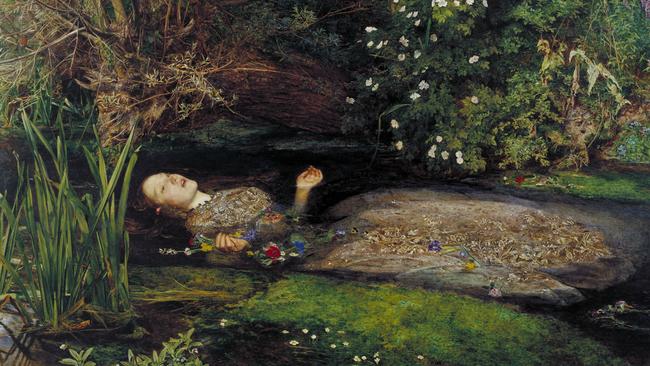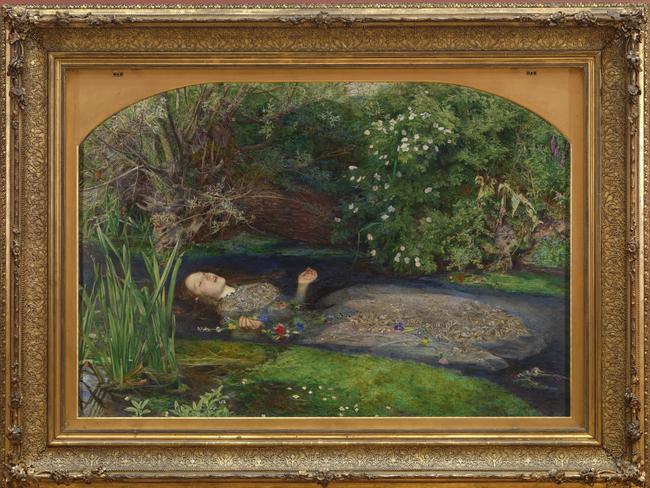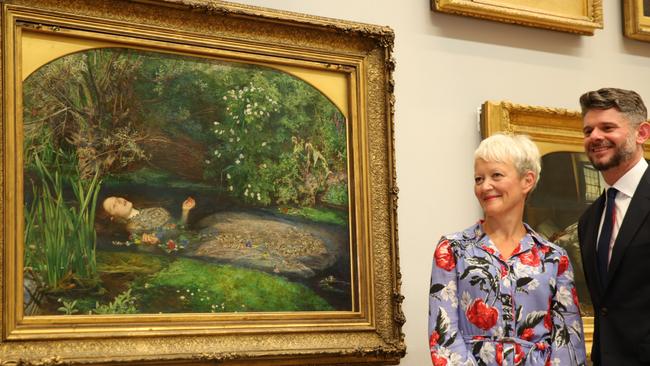London’s best-loved painting is taken off the wall of the Tate museum and sent to Canberra
FORGET Brexit, separation anxiety will hit Great Britain for real when London’s best-loved painting is taken off the wall of the Tate museum and sent to Canberra.

NSW
Don't miss out on the headlines from NSW. Followed categories will be added to My News.
FORGET Brexit. Separation anxiety will hit Great Britain for real when London’s best-loved painting is taken off the wall of the Tate museum and sent to Canberra.
The picture so close to London’s heart is Ophelia, created in 1851-52 by British prodigy painter Sir John Everett Millais.
Ophelia hangs permanently at the Tate Britain museum on the Thames, where the locals can see it any time free of charge.
But the beautiful though tragic Ophelia, famous from Shakespeare’s play Hamlet, is set to leave London for her first ever trip to Australia. She will form the centrepiece of this country’s most comprehensive exhibition of the so-called Pre-Raphaelite painters.
Love and Desire: Pre-Raphaelite Masterpieces from Tate will be on exhibition at the National Gallery of Australia for over four months from December 14 this year until April 28, 2019.
The announcement was made in London today by National Gallery of Australia director Nick Mitzevich and Tate director Maria Balshaw.
Many visitors travel across the world to see Ophelia at the Tate, Dr Balshaw said.
“People come up the front steps, ask our visitor assistance, ‘where can I find Ophelia?’,” she said.
“They are of huge importance to the history of British art and we are delighted to be sharing them with a wider public.”

The locals are notoriously bereft whenever their beloved Ophelia leaves their shores, as she last did in 2012-14 when she toured to Washington, Moscow and Tokyo.
People have been known to burst into tears of disappointment to find Ophelia away on loan.
And this time, Ophelia is taking her almost-as-famous sister, The Lady of Shalott, with her. It is the first time in Tate history that the two cult pictures have left the museum at the same time, according to Tate curator Carol Jacobi.
The Lady of Shalott was painted in 1888 by another Pre-Raphaelite star called John William Waterhouse. The painting is based on the Tennyson poem about the beautiful woman in a tower who drifts downstream to see Sir Lancelot, with whom she is smitten. She dies on the way, leaving a beautiful corpse.
MORE NEWS:
IBRAHIM ASSOCIATE ADMITS TO SYNDICATE ROLE
TRADIE DEATH ‘NOTHING TO DO WITH ME’
COAL MINERS FREED FROM DODGY LIFT
A total of 43 paintings from the Tate’s unequalled Pre-Raphaelite collection are coming to Canberra. A further 50 Pre-Raphaelite works are being borrowed from UK and Australian collections, both public and private.
The Pre-Raphaelites created works that were “raw, poetic and sexy”, Nick Mitzevich said.
Inspired by Medieval art and life, the Pre-Raphaelites made their name the same way the Impressionists did — by their total rejection of the orthodox, academic art teaching of their time, and by inventing an entirely new and distinctive style of painting that was at first derided by later acclaimed.

Co-curators of the Pre-Raphaelite exhibition are the Tate Britian’s Carol Jacobi and the NGA’s Lucina Ward.
The Pre-Raphaelite Brotherhood, as the artists called themselves, was formed in 1848 in London and included Millais and Waterhouse as well as William Holman Hunt, Dante Gabriel Rossetti and others.
These artists were young and radical, Mitzevich said.
“The Pre-Raphaelites were a rebellious group drawing inspiration from some of the great love stories of history and literature, lustful entanglements and the wonder of religious icons,” he said.
“There is so much richness and beauty in each work I know visitors will be in awe of these masterpieces.”
Ophelia’s travels are considerable. The painting was considered a marvel of bravura technique and toured to Paris in 1855, 1872 and 1972, to Berlin and Madrid in 2004-2005, and to Amsterdam and Japan in 2007-2008. Next stop, Canberra.
Ophelia is not such a heavyweight as The Lady of Shalott. She might look ethereal, but together with her ornate frame The Lady of Shalott weighs as much as two very large men, according to Tate head of international collection exhibitions, Daniel Slater.
Nick Mitzevich will be looking for a nice sturdy wall to hang this most delicate of British heroines.
The writer travelled to London courtesy of the National Gallery of Australia

